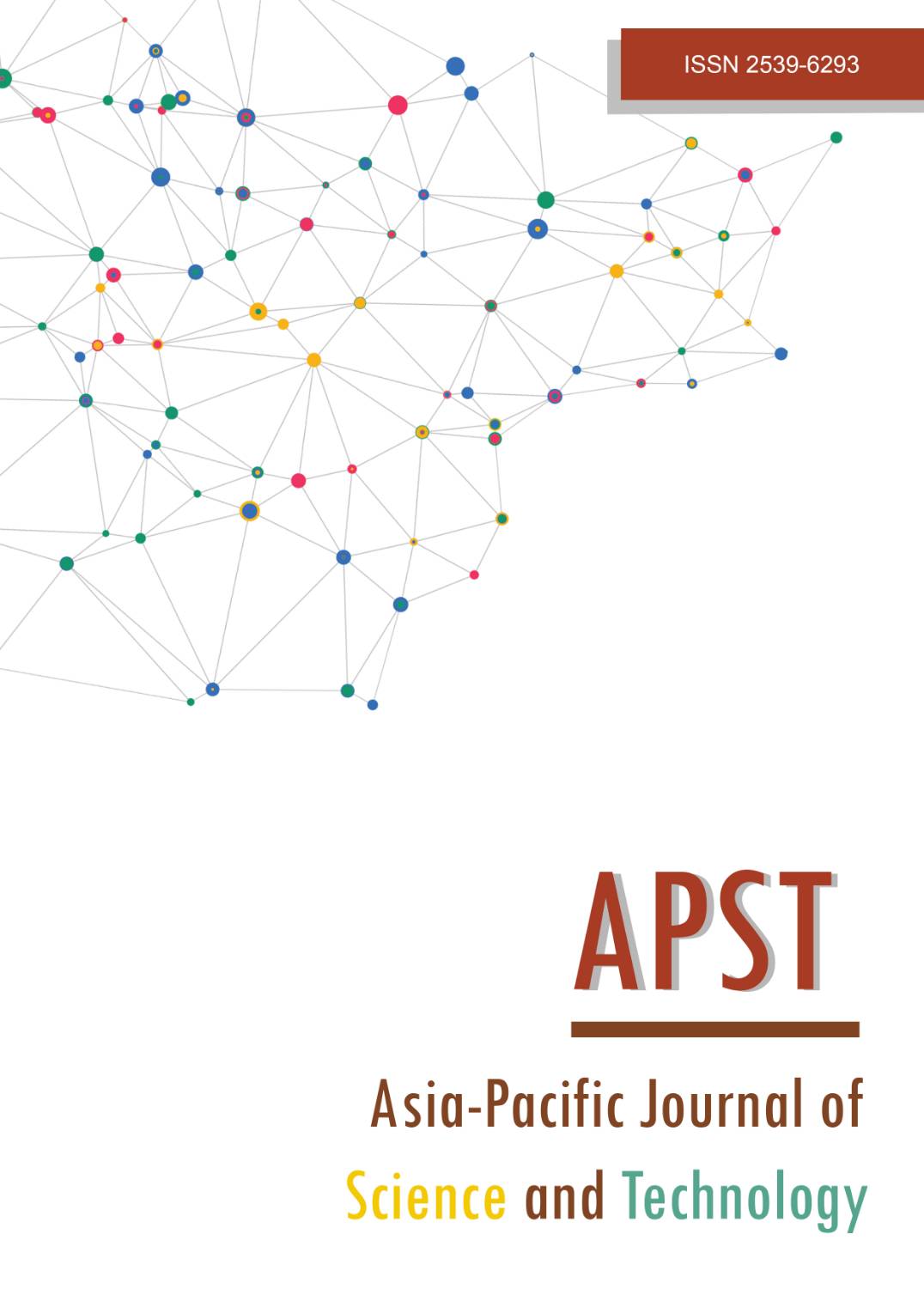Stimulation of beta-glucan production from Saccharomyces carlsbergensis RU01 by tannin
Main Article Content
Abstract
This study aimed to evaluate the tannin-stimulated production of β-glucan from Saccharomyces carlsbergensis RU01 in molasses medium. Central composite design was used for the experiment design. The optimum concentrations of molasses (X1), ammonium sulfate (X2), and tannin (X3), which produced the highest biomass, were determined. Optimization analysis revealed that the optimum concentration of substrates for biomass was 3% (w/v) of molasses, 0.1% (w/v) of ammonium sulfate and 0.1% (w/v) of tannin. The maximum biomass production was 2.64 g/L. Meanwhile, the experimental validation was 2.84±0.10 g/L, and the highest β-glucan production was 119.47 mg/g of dry cell weight. Carbohydrate content in yeast cell walls was detected by Congo red staining. The cell wall of yeast grown in the optimized medium with tannin showed higher intensity than that grown in yeast malt medium. These results suggested that tannin addition can enhance β-glucan production with a high β-1,3-glucans content in the cell wall of S. carlsbergensis RU01.
Article Details
References
Klis FM, Mol P, Hellingwerf K, Brul S. Dynamics of cell wall structure in Saccharomyces cerevisiae.
FEMS.2002;26(3):239-256.
Thammakiti S, Suphantharika M, Phaesuwan T, Verduyn C. Preparation of spent brewer’s yeast β-glucans for potential applications in the food industry. Int J Food Sci Tech. 2004;39(1):21-29.
Worrasinchai S, Suphantharika M, Pinjai S, Jamnong P. β-Glucan prepared from spent brewer’s yeast as a fat replacer in mayonnaise. Food Hydrocoll. 2006;20(1):68-78.
Cheung PCK. Dietary fiber content and composition of some cultivated edible mushroom fruiting bodies and mycelia. J Agric Food Chem. 1996;44(2):468-471.
Rajarathnam S, Shashirekha MN, Bano Z. Biodegradative and biosynthetic capacities of mushrooms: present and future strategies. Crit Rev Biotechnol. 1998;18(2-3):91-236.
Kogan G, Kocher A. Role of yeast cell wall polysaccharides in pig nutrition and health protection. Livest Sci. 2007;109(1):161-165.
Fitzpatrick FW, Haynes LJ, Silver NJ, Dicarlo FJ. Effect of glucan derivatives upon phagocytosis by mice. J Reticuloendothel Soc. 1964;15:423-428.
Bohn JA, BeMiller JN. (1-3)-β-D-Glucans as biological response modifiers: a review of structure-functional activity relationships. Carbohydr Polym. 1995;28(1):3-14.
Li J, Li DF, Xing JJ, Cheng ZB, Lai CH. Effect of beta glucan extracted from Saccharomyces cerevisiae on growth performance and immunological and somatotropic response of pigs challenged with Escherichia coli lipopolysaccharide. J Anim Sci. 2006;84(9):2374-2381.
Vaclav V, Jana V. Physiological effects of different types of β-glucan. Biomed Pap Med Fac Univ Palacky Olomouc Czech Repub. 2007;151(2):225-231.
Bacon J, Farmer V, Jones D, Taylor J. The glucan component of the cell wall of baker’s yeast (Saccharomyces cerevisiae) considered in relation to its ultrastructure. Biochem J. 1969;114(3):557- 567.
Kath F, Kulicke WM. Mild enzymatic isolation of mannan and glucan from yeast Saccharomyces cerevisiae. Angew Makromol Chem. 1999;268 (1):59-68.
Nour S, Gendy E, Mardian HR, Amr SSA. Design and optimization of a process for sugarcane molasses fermentation by Saccharomyces cerevisiae using response surface methodology. Int J Microbiol. 2013;2013;1-9.
Ene IV, Walker LA, Schiavone M, Lee K, Martin YH, Dague E, et al. Cell wall remodeling enzymes
modulate fungal cell wall elasticity and osmotic stress resistance. Microbiol Res. 2015;6(4):6-15.
Wang JN, Li AM, Xu L, Zhou Y. Adsorption of tannic and gallic acids on a new polymeric adsorbent and the effect of Cu(II) on their removal. J Hazard Mater. 2009;169(1-3):794-800.
Aelenei N, Popa MI, Novac O, Lisa G, Balaita L. Tannic acid incorporation in chitosan-based microparticles and in vitro controlled release. J Mater Sci Mater Med. 2009;20(5):1095-1102.
Bouki E, Dimitriadis VK, Kaloyianni M, Dailianis S. Antioxidant and pro-oxidant challenge of tannic acid in mussel hemocytes exposed to cadmium. Mar Environ Res. 2013;85:13-20.
Monkontanawat N, Sanguandeekul R, Phakitchaiwattana C, Xiao H, Mclandsborough LA, Methacanon P. Influence of additives on Saccharomyces cerevisiae β-glucan production. Inter Food Res J. 2013;20(4):1953-1959.
Olbrich H. The molasses. 1st ed. Berlin: Biotechnologie-Kempe GmbH; 2006.
Jae YC, Jin CP, Beong SJ, Young CL, Young SC. Optimal fermentation conditions for enhanced glutathione production by Saccharomyces cerevisiae FF-8. J Microbiol. 2004;42(1):51-55.
Negrulescu A, Patrulea V, Mincea MM, Cosmin I, Beatrice AV, Vasile O. Adapting the reducing sugars method with dinitrosalicylic acid to microtiter plates and microwave heating. J Brazilian Chem Soc. 2012;23(12):2176-2182.
Xiao YL, Qiang W, Steve WC, Hong ZL. A new isolation method of β-D-glucans from spent yeast Saccharomyces cerevisiae. Food Hydrocoll. 2008;22(2):239-247.
Semedo MC, Karmali A, Fonseca L. A high throughput colorimetric assay of β-1,3-D-glucans by Congo red dye. J Microbiol Methods. 2015;140-148.
Chodakowska MI, Witkowska AM. Evaluation of polish wild mushrooms as beta-glucan sources. Int J
Environ Res Public Health. 2020;17(19):1-18.
Manners DJ, Masson AJ, Patterson JC, Björndal H, Lindberg B. The structure of a β-(1→3)-D-glucan from yeast cell walls. Biochem J. 1973;135(1):3-36.
Chema B, Fabienne F, Guilhem J, Michel P, Chistophe B, Phillipe T. Enzymatic process for the fractionation of baker’s yeast cell wall (S. cerevisiae). Food Chem. 2014;163:108-113.
Pathisssery JS, Rosamma PA. Molasses based fermentation medium for marine yeast biomass production. Mar Sci. 2013;2:39-44.
Mekoue NJ, Vernhet A, Sieczkowski N, Brillouet JM. Interactions of condensed tannins with Saccharomyces cerevisiae yeast cells and cell walls: Tannin location by microscopy. J Agric Food Chem. 2015;63(34):39-45.
Selin S, Nahit A, Nurettin S. Modified bifunctional p (tannic acid) microgels and their antimicrobial activity. Appl Surf Sci. 2015;354:306-331.


